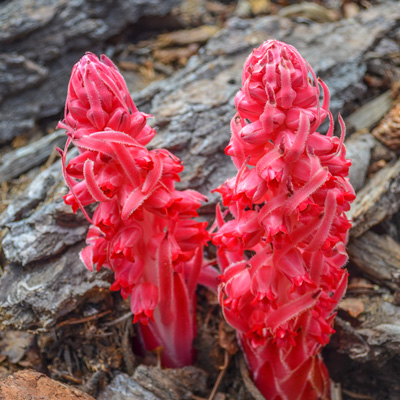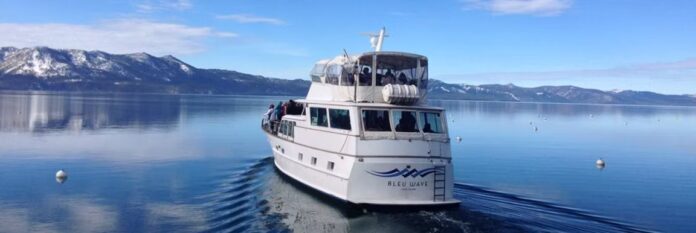An Intro to Lake Tahoe’s Wildflower Season
Written by Kendal Scott
One of the many perks of living in Tahoe is our long and varied wildflower season. As flowers pass their prime at lower elevations or along south-facing slopes, they start to bloom uphill and in nearby shady pockets. This means you can find colorful pockets of wildflowers along Lake Tahoe’s hiking trails throughout the entire summer.
At any given location, you can track the sequence of species that bloom at different times within the season. Snow Plants and Longhorned Steer’s Head bloom alongside still melting snow, while Rubber Rabbitbrush, a food source that pollinators rely upon into the fall, won’t bloom until late season.

Image from Keep Tahoe Blue

Image from Wild Macro

Image from L&H Seeds
Because of our varying snowpack and spring weather, every year is different. Planning a mid-summer wildflower hike may require thinking back to how much snow fell in, say, February. But no matter what the timing, there’s always a few spots around the lake where you can soak in the colors that summer wildflowers bring.
Wildflower Hikes along Lake Tahoe’s West Shore
On the west shore, Meek’s Creek is a flat hike through a wet meadow (you may want bug spray for this spot!) where you can find Crimson Columbine. These red flowers attract hummingbirds, who hover and reach their long bills into the tubular flower to get at nectar that is tucked away just for them.

Image from Wild Macro

Image from John O’Neill
Crimson Columbines lack much of a scent, as their desired hummingbird pollinators do not have a sense of smell. This makes an interesting contrast to another Sierra Nevada variety, Sierra Columbine, which grows further south and releases a sweet fragrance that attracts Hawk Moths in the dark of night.
Meeks Creek is also a great spot to search for various white flowers, including Rein Orchids, Starry Ladies’ Tresses (another orchid), and Corn Lilies. Many Tahoe residents are unaware of our native orchids, some of which were thought to have been extirpated from the basin until recently.

Image from the US Forest Service

Image from Yosemitehikes.com

Wildflower Big Years, citizen science efforts hosted by the Tahoe Institute for Natural Science (TINS) have revealed and documented their persistence in recent years. Tall white Corn Lilies are widespread in the wet soil of the meadow. A smaller white flower, Mariposa Lilies are also found growing low to the ground in dry, open areas.
At Squaw Valley, you can find wildflowers late into the summer months by hiking the Shirley Canyon trail up to High Camp. Here you can spot several species such as Owls Clover and fields of paintbrushes.

Image from Wild Macro

© 2006 Steve Matson
Tahoe is home to nine species of paintbrushes ranging in color from white to pink to red. Paintbrushes are hemiparasitic; they are able to grow and photosynthesize on their own, but commonly pilfer via root connections, drawing nutrients from neighboring plants, such as sagebrush.
Wildflower Hikes along Lake Tahoe’s South Shore
While on the south shore, take Highway 88 to Carson Pass visitors center. From there, you can take one trail to both Frog and Winnemucca lakes. Another popular option is a loop to Winnemucca and Round Top lakes from the Woods Lake trailhead further west.
These are among the most popular wildflower hikes in the Lake Tahoe region, and with good reason! If kids are in tow, put them to work searching for plants that echo the faces of familiar animals.


Image from Sierrawildflowers.org
Both Little Elephants Head and its slightly larger and later cousin, Big Elephants Head, take root in the wet meadows along the trail. Their pink to purple flowers resemble the ears and spiraling trunk of an elephant growing along the top of an erect stem. Both species are “buzz pollinated,” releasing pollen in an explosive cloud when visiting bees buzz at a particular frequency, and like paintbrush, are also hemiparasitic on other plants.
Continuing on up to Winnemucca Lake, you may find low shrubs of Alpine Heather, or Cassiope, a small, white, bell-shaped flower that was a favorite of John Muir. Other flowers that can be found in the area include Shooting Stars and dangling Mountain Bluebells.

Image from Americansouthwest.net

Image from AceSierra on Summit Post

Image from gardenia.net
Wildflower Hikes along Lake Tahoe’s North Shore
On the north shore, pack your layers and head up to Mount Rose Summit for wildflowers and views of Lake Tahoe all in one hike. The best flowers bloom along Relay Peak Road where you will find two of Tahoe’s large yellow daisy-shaped flowers that are often mistaken for one another.

Image from Leslie Seaton / CC BY

Image from NationalPark.Guide
Arrow-leaved Balsamroot blooms first. Their flowers tower over their leaves, which have a distinct arrow shape, with deep lobes at the base of the leaves. Mule’s Ear is much more widespread. Their flowers arrive a week or two after the balsamroots have started, and their flowers stand at roughly the same height as their woolly leaves.
When minty aromas fill the air, the clumped purple flowers of Mountain Pennyroyal are likely nearby, a favorite nectar plant to nearly every butterfly in Tahoe. More purple flowers grow along the trail in the form of Showy Penstemon, a tubular flower with five fused petals that favors pollination by bees. Similar in shape, but cloaked in bright magenta petals, Mountain Pride grows in granitic soils along this route.

Image from Inlandvalleygardenplanner.org

Image from Reddit user u/danpietsch

Image from Tedmuller.us
Galena Creek Falls is a great place to stop for lunch, and makes for a popular loop back to the trailhead if you don’t wish to continue climbing another 2.5 miles to the summit.
If you do press on, plenty of wildflowers await, including the pale pink to yellow Alpine Paintbrush, Showy Polemonium found above 8,000’, small white phloxes that change to pink as they are pollinated, and high-elevation specialties like Tahoe Draba and Rose Buckwheat.

Image from Jim Morefield on Flickr

Image from Jim Morefield (CC BY-SA)

Image from Ryan Kaldari / Public domain
If the suggestions above feel a bit “been there, done that,” try finding your own wildflower hike in Desolation Wilderness.
Plan a route that takes you up a few thousand feet in elevation, such as Mount Tallac. As you climb, watch how the flowers change. Note what colors, types of symmetry, and flower shapes and sizes can be found. What kinds of habitat do you pass through and what flowers do you find in these habitats?
While chasing wildflowers, remember to leave them for the bees, beetles, birds, and other wildflower enthusiasts. Do not pick them. Instead, take some photos, or better yet a sketch book and some colored pencils. Paying attention to details, such as the number of petals on a lily or becoming familiar with the shape of lupine leaves, is one of the best ways to learn.
Heading out on a wildflower hike around Lake Tahoe? Share your wildflower finds with us on Instagram! Tag @tahoesnaturalists or use the hashtags #tahoenaturalists & #epiclaketahoe.
This post is a guest contribution by Kendal Scott of the Tahoe Institute for Natural Science; a local non-profit dedicated to advancing the natural history, conservation, and ecosystem knowledge of the Tahoe region through science, education, and outreach.
For more ideas about where to find Tahoe’s wildflowers, or if you are looking for more information on other flora and fauna, contact the Tahoe Institute for Natural Science at (775) 298-0060.



